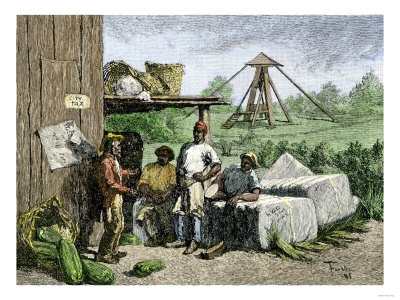
From the" Geography of the Cotton Trade," published in 1920: The manufacturing of cotton is often carried on far from the plantations. Most cotton-producing nations also have cotton manufactures, but the entire product of the nation is seldom used up at home. The kind of cotton produced is in some cases not entirely suitable for complete manufactures; hence imports of other varieties and qualities may be necessary, while the unused surplus is sent elsewhere.

Extent of cotton trade.-By comparing a country's production of raw cotton with the consumption of its cotton factories we can get some idea of the vast world trade carried on in raw cotton. Absolutely accurate figures are unobtainable; the following table is, however, fairly dependable. It does not account for all of the cotton raised and manufactured, but what it does show will give an idea of the immensity of the trade in raw cotton.
It is clear from this table that a great deal of cotton is moved from places where it is produced to distant places where it is to be worked into yarns and fabrics. The discrepancies that occur in the table, such as a greater consumption by the factories than production and importation for the year, 1910, may be accounted for by possible stocks of raw cotton on hand from the previous year, for these are not included under production or imports. Again, much of the surplus not consumed was either stored over into the year 1911 or reexported to other countries.
Countries interested in the cotton trade.-Where does the cotton from the great cotton-producing countries go? By reference to the table it is clear that it must go to the great cotton-consuming or manufacturing nations that produce no raw cotton. The surplus of cotton from the United States, India, Egypt, China, Peru, Turkey, and Russia must go to Great Britain, Germany, Japan, France, Italy, Austria, etc. Some of the cotton going to England is reexported from there to other nations.

Cotton-exporting markets.-Naturally certain cities in the cotton-producing countries have become important as cotton-exporting centers. In the United States, Galveston ranks highest in number of bales received and shipped, the amount running considerably over 2,000,000 bales per year. New Orleans and Savannah come next. New Orleans usually holds second place with a total yearly average of nearly 2,000,00o bales, but in 1910 the amount ran down to 1,315,000 bales and Savannah came into second place with 1,365,000 bales. The other important cities receiving and shipping cotton in the southern United States are: Norfolk, Virginia; Wilmington, North Carolina; Mobile, Alabama; Brunswick and Charleston, South Carolina. Considerable cotton is received overland at Baltimore, New York, Philadelphia, and even at Boston from the cotton states.

The chief exporting ports in the other cotton-producing countries are Bombay and Madras in India, Alexandria in Egypt, and Shanghai in China.
Cottan-importing markets.-Similarly, certain large cities have become prominent as the receiving centers for the great cotton-importing countries. No city in the world receives so much cotton as Liverpool. England's high rank as a cotton textile producer accounts for this, although a great deal of cotton received in Liverpool is reshipped in smaller quantities to various parts of Europe and elsewhere. American spinners frequently buy Egyptian or East Indian cotton in Liverpool. A few miles inland from Liverpool is another great cotton market, Manchester, the very heart of the cotton textiles manufacturing district of England. Cotton received here is used in the immediate vicinity.

Bremen and Hamburg are the chief cotton-receiving cities of Germany. Bremen gets mainly the American cottons, and Hamburg those from East India and Egypt. No small part of Hamburg's import, however, goes to Bremen before being sold to the manufacturer. Both Hamburg and Bremen supply cotton mills in all parts of Germany, Austria, Switzerland, Netherlands, and Russia. Belgium also gets some cotton from Bremen, but more from Liverpool.

Havre is the great cotton-receiving port in France. Most of the cotton received comes directly from the United States, some from Liverpool, and a little from Hamburg. Dunkirk is the second greatest cotton-importing city in France. It receives American cottons mainly, whereas Marseilles in southern France receives considerable cotton from Egypt and India.
Reval is the chief cotton-importing city of Russia. Others of importance are St. Petersburg, Alexandrovo, and Odessa. Most of the cotton comes direct from the United States, but a good deal is transshipped from Liverpool, Bremen, and Hamburg. Persian and Egyptian cottons are received in considerable amounts at Odessa.
Barcelona is the chief cotton-receiving point in Spain. Rotterdam and Enscheide come first in Netherlands. Much of the cotton imported at these points comes directly from Germany and England. Gottenburg and Norrkoping in Sweden, Christiania in Norway, Oporto in Portugal, Kobe and Yokohama in Japan are the chief cotton-receiving cities in the countries named.


Extent of cotton trade.-By comparing a country's production of raw cotton with the consumption of its cotton factories we can get some idea of the vast world trade carried on in raw cotton. Absolutely accurate figures are unobtainable; the following table is, however, fairly dependable. It does not account for all of the cotton raised and manufactured, but what it does show will give an idea of the immensity of the trade in raw cotton.
It is clear from this table that a great deal of cotton is moved from places where it is produced to distant places where it is to be worked into yarns and fabrics. The discrepancies that occur in the table, such as a greater consumption by the factories than production and importation for the year, 1910, may be accounted for by possible stocks of raw cotton on hand from the previous year, for these are not included under production or imports. Again, much of the surplus not consumed was either stored over into the year 1911 or reexported to other countries.
Countries interested in the cotton trade.-Where does the cotton from the great cotton-producing countries go? By reference to the table it is clear that it must go to the great cotton-consuming or manufacturing nations that produce no raw cotton. The surplus of cotton from the United States, India, Egypt, China, Peru, Turkey, and Russia must go to Great Britain, Germany, Japan, France, Italy, Austria, etc. Some of the cotton going to England is reexported from there to other nations.

Cotton-exporting markets.-Naturally certain cities in the cotton-producing countries have become important as cotton-exporting centers. In the United States, Galveston ranks highest in number of bales received and shipped, the amount running considerably over 2,000,000 bales per year. New Orleans and Savannah come next. New Orleans usually holds second place with a total yearly average of nearly 2,000,00o bales, but in 1910 the amount ran down to 1,315,000 bales and Savannah came into second place with 1,365,000 bales. The other important cities receiving and shipping cotton in the southern United States are: Norfolk, Virginia; Wilmington, North Carolina; Mobile, Alabama; Brunswick and Charleston, South Carolina. Considerable cotton is received overland at Baltimore, New York, Philadelphia, and even at Boston from the cotton states.

The chief exporting ports in the other cotton-producing countries are Bombay and Madras in India, Alexandria in Egypt, and Shanghai in China.
Cottan-importing markets.-Similarly, certain large cities have become prominent as the receiving centers for the great cotton-importing countries. No city in the world receives so much cotton as Liverpool. England's high rank as a cotton textile producer accounts for this, although a great deal of cotton received in Liverpool is reshipped in smaller quantities to various parts of Europe and elsewhere. American spinners frequently buy Egyptian or East Indian cotton in Liverpool. A few miles inland from Liverpool is another great cotton market, Manchester, the very heart of the cotton textiles manufacturing district of England. Cotton received here is used in the immediate vicinity.

Bremen and Hamburg are the chief cotton-receiving cities of Germany. Bremen gets mainly the American cottons, and Hamburg those from East India and Egypt. No small part of Hamburg's import, however, goes to Bremen before being sold to the manufacturer. Both Hamburg and Bremen supply cotton mills in all parts of Germany, Austria, Switzerland, Netherlands, and Russia. Belgium also gets some cotton from Bremen, but more from Liverpool.

Havre is the great cotton-receiving port in France. Most of the cotton received comes directly from the United States, some from Liverpool, and a little from Hamburg. Dunkirk is the second greatest cotton-importing city in France. It receives American cottons mainly, whereas Marseilles in southern France receives considerable cotton from Egypt and India.
Reval is the chief cotton-importing city of Russia. Others of importance are St. Petersburg, Alexandrovo, and Odessa. Most of the cotton comes direct from the United States, but a good deal is transshipped from Liverpool, Bremen, and Hamburg. Persian and Egyptian cottons are received in considerable amounts at Odessa.
Barcelona is the chief cotton-receiving point in Spain. Rotterdam and Enscheide come first in Netherlands. Much of the cotton imported at these points comes directly from Germany and England. Gottenburg and Norrkoping in Sweden, Christiania in Norway, Oporto in Portugal, Kobe and Yokohama in Japan are the chief cotton-receiving cities in the countries named.

In the United States, Boston ranks first as a cotton-importing city. This may be accounted for by its closeness to the cotton-manufacturing section of New England. Philadelphia and New York follow.
Liverpool, Bremen, Havre, New York, and Boston are the dominant cotton markets of the world. At each of these places there is a large association of business men whose sole purpose it is to promote commerce in raw cotton. The associations are known as cotton exchanges. In each of these cities is a large building used by the association for commercial trading. The working of the great exchanges is similar to that of the smaller and more general cotton exchanges already described. The prices made at these great exchanges govern the cotton markets everywhere else. Since the greatest volume of cotton trading takes place at Liverpool, the Liverpool market is watched with greatest care not only by dealers in raw cotton, but also by cotton manufacturers, dealers in finished goods, and even by retail dry goods merchants. When cotton prices in Liverpool go up or down, cotton prices elsewhere are likely to follow their lead.
Why the greatest cotton market is not in the United States.-The main reason why the United States, the greatest cotton-producing country in the world, is not the world's chief cotton market, is that the cotton is shipped from the farms to places widely separated. The cotton mills of this country are scattered over an extraordinarily wide area; no one point, therefore, could serve profitably as a cotton market and jobbing center.


Some genuinely prize content on this internet site , saved to favorites ….
ReplyDeleteCotton Exports
Freed slaves was crunch fitness price per month
ReplyDeleteto own their own land and work for themselves. In Jamaica, many abandoned the plantations in search of their own.